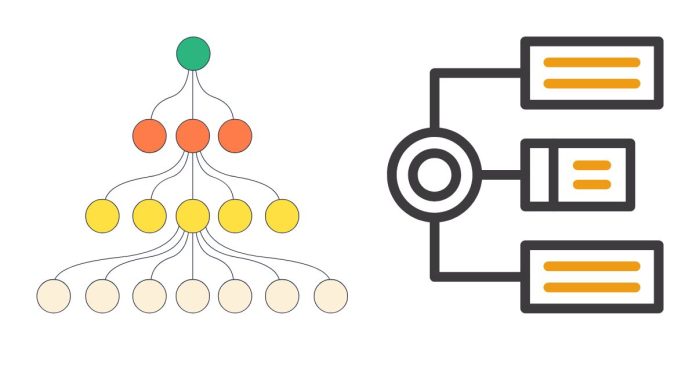Graph algorithms are computational methods that operate on graphs, which are structures consisting of vertices (nodes) connected by edges. These algorithms solve problems related to pathfinding, connectivity, spanning trees, and more. Below are key types of graph algorithms and their applications.
1. Graph Representation
Graphs can be represented in different ways:
- Adjacency Matrix: A 2D matrix where a cell
(i, j)is1(or the edge weight) if there’s an edge between verticesiandj, otherwise0. - Adjacency List: A list where each vertex points to a list of its connected vertices.
- Edge List: A list of all edges represented as pairs
(u, v)or triples(u, v, w)(with weights).
2. Categories of Graph Algorithms
A. Traversal Algorithms
- Depth-First Search (DFS):
- Explores as far as possible along each branch before backtracking.
- Used in:
- Detecting cycles.
- Finding connected components.
- Topological sorting.
- Breadth-First Search (BFS):
- Explores all neighbors of a vertex before moving to the next level.
- Used in:
- Finding the shortest path in an unweighted graph.
- Checking bipartiteness.
B. Shortest Path Algorithms
- Dijkstra’s Algorithm:
- Finds the shortest path from a source vertex to all other vertices in a graph with non-negative edge weights.
- Time Complexity: O(V2)O(V^2) (or O((V+E)logV)O((V + E) \log V) with a priority queue).
- Bellman-Ford Algorithm:
- Finds the shortest path from a source vertex to all vertices, even with negative edge weights.
- Time Complexity: O(VE)O(VE).
- Floyd-Warshall Algorithm:
- Finds shortest paths between all pairs of vertices.
- Time Complexity: O(V3)O(V^3).
- A* Algorithm:
- A heuristic-based algorithm for shortest paths, often used in AI and game development.
C. Minimum Spanning Tree (MST) Algorithms
- Prim’s Algorithm:
- Builds an MST by starting from an arbitrary vertex and adding the smallest edge that connects to a new vertex.
- Time Complexity: O(V2)O(V^2) (or O(ElogV)O(E \log V) with a priority queue).
- Kruskal’s Algorithm:
- Builds an MST by sorting all edges and adding them in order, ensuring no cycles are formed.
- Time Complexity: O(ElogE)O(E \log E).
D. Network Flow Algorithms
- Ford-Fulkerson Algorithm:
- Finds the maximum flow in a flow network.
- Time Complexity: O(E⋅max-flow)O(E \cdot \text{max-flow}).
- Edmonds-Karp Algorithm:
- A specific implementation of Ford-Fulkerson using BFS for finding augmenting paths.
- Time Complexity: O(VE2)O(VE^2).
E. Cycle Detection
- DFS-Based Cycle Detection:
- In directed graphs, checks for back edges during DFS.
- In undirected graphs, uses a parent pointer.
- Union-Find Algorithm:
- Detects cycles in undirected graphs using the disjoint-set data structure.
F. Topological Sorting
- Definition: Orders vertices of a directed acyclic graph (DAG) such that for any directed edge u→vu \to v, uu appears before vv.
- Algorithms:
- DFS-Based Topological Sort.
- Kahn’s Algorithm (uses in-degree counts).
G. Connectivity Algorithms
- Tarjan’s Algorithm:
- Finds strongly connected components (SCCs) in directed graphs.
- Time Complexity: O(V+E)O(V + E).
- Kosaraju’s Algorithm:
- Another method to find SCCs using two passes of DFS.
3. Applications of Graph Algorithms
- Social Networks: Finding influencers, communities, and shortest connections.
- Navigation Systems: Pathfinding in road networks (e.g., Google Maps).
- Telecommunications: Optimizing network flows and MSTs for cost-efficient cabling.
- Biology: Analyzing protein interaction networks.
- Computer Networks: Detecting loops, routing packets, and managing data flow.
4. Example: BFS Pseudocode
def BFS(graph, start):
visited = set()
queue = [start]
visited.add(start)
while queue:
vertex = queue.pop(0)
print(vertex)
for neighbor in graph[vertex]:
if neighbor not in visited:
visited.add(neighbor)
queue.append(neighbor)
5. Summary Table
| Algorithm Type | Key Algorithms | Use Case |
|---|---|---|
| Traversal | DFS, BFS | Exploring and searching graphs. |
| Shortest Path | Dijkstra, Bellman-Ford | Finding minimum paths. |
| Minimum Spanning Tree | Prim, Kruskal | Connecting nodes with minimal cost. |
| Network Flow | Ford-Fulkerson, Edmonds-Karp | Maximizing flow in a network. |
| Cycle Detection | DFS, Union-Find | Detecting loops in graphs. |
| Topological Sorting | Kahn, DFS-Based Sort | DAG processing. |
| Connectivity | Tarjan, Kosaraju | Finding connected components. |
Graph algorithms are fundamental tools for solving real-world problems, ranging from optimization to network analysis. Understanding these algorithms and their applications equips you to tackle a wide variety of challenges in computer science.


